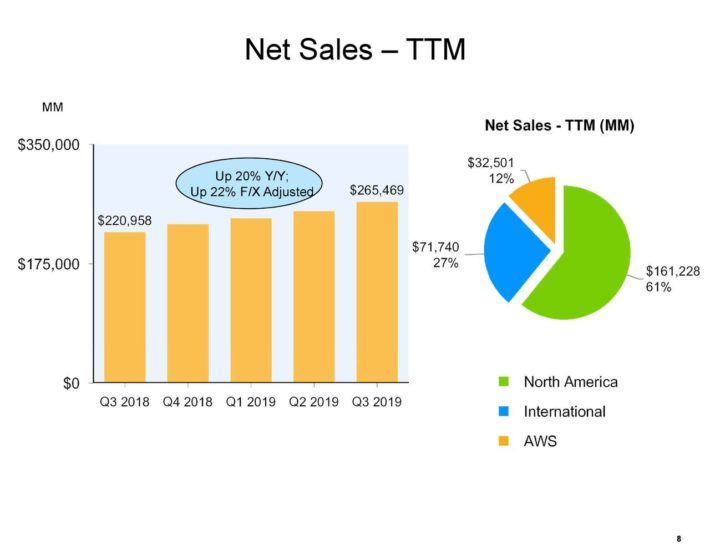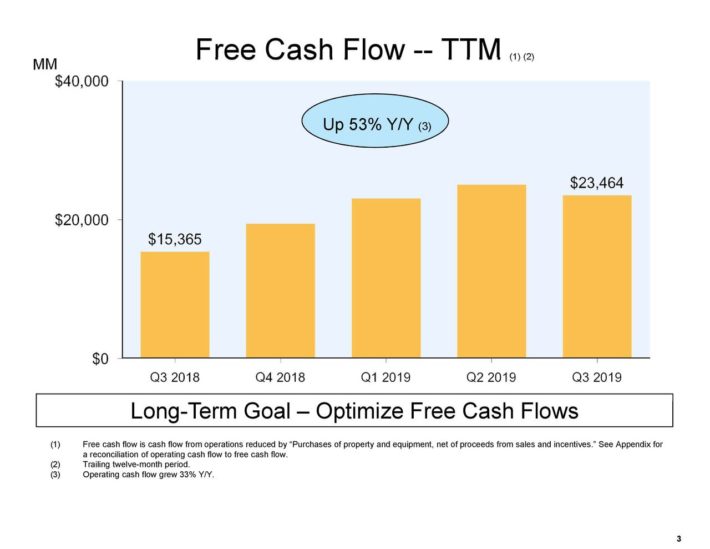Updated on January 23rd, 2020 by Bob Ciura
Over the past decade, many technology companies such as Apple, Inc. (AAPL), Cisco Systems (CSCO) and more have initiated dividend payments to shareholders.
There are now over 300 dividend-paying technology stocks, which makes the technology sector a surprisingly good source of dividend payers.
While the technology industry has widely embraced dividends, not all tech companies pay dividends. One lingering holdout to the notion of paying dividends to shareholders is e-commerce giant Amazon.com Inc. (AMZN).
Despite climbing to a market capitalization above $900 billion, with over $230 billion in annual revenue, Amazon still does not pay a dividend to shareholders.
We’ve compiled a list of all ~330 dividend-paying technology stocks complete with important investing metrics, which you can access below:
Rather than return cash to shareholders, Amazon continues to plow its cash flow back into the business.
The decision whether or not a company should pay a dividend depends on many factors. Thousands of stocks pay dividends to shareholders, and an elite few have maintained long histories of raising their dividends every year.
For example, the Dividend Aristocrats are a group of 57 stocks in the S&P 500 that have raised their dividends for 25+ years in a row.
You can download an Excel spreadsheet of all 57 (with metrics that matter) by clicking the link below:
Amazon’s lack of a dividend certainly has not hurt investors to this point, as Amazon has been a premier growth stock. Over the past 10 years, Amazon stock generated returns of over 30% per year.
But for income investors, Amazon may not be an attractive option. This article will discuss the chances of Amazon ever paying a dividend.
Business Overview
Amazon is an online retailer that operates a massive e-commerce platform where consumers can buy virtually anything with their computers or smartphones. It operates through the following segments:
- North America
- International
- Amazon Web Services
The North America and International segments include the global retail platform of consumer products through the company’s websites. The Amazon Web Services segment sells subscriptions for cloud computing and storage services to consumers, start-ups, enterprises, government agencies, and academic institutions.
Amazon’s e-commerce operations fueled its massive revenue growth over the past decade. Consider that in 2008, Amazon generated revenue of $14.84 billion. Sales reached $232.9 billion in 2018, an amazing level of growth over the past decade.
Sales continued to grow in 2019:
Source: Earnings Presentation
Of course, Amazon’s huge revenue growth did not come easy (or cheap). Amazon had to spend huge amounts of money to build its retail operation. As a result, Amazon had razor-thin profit margins for many years of its growth phase. That said, the company was profitable in every year over the past decade except 2014.
For the most recent quarter, Amazon generated $70 billion in revenue, a 25% increase compared to the same quarter last year, excluding the negative impact of foreign exchange. Net income declined 28% to $2.1 billion, as the company elevated its investment spending. On a per-share basis, Amazon’s earnings were $4.23, down from $5.75 per share in the year-ago period.
While the retail business continues to operate at very low gross margins, the AWS segment is highly profitable, and is largely the reason for Amazon’s impressive earnings growth. Such strong earnings growth improves Amazon’s chances of paying a dividend at some point in the future. That said, the company still plans to invest heavily in growth.
Growth Prospects
As is typical with many technology companies, growth investment is Amazon’s top strategic priority. This is partly out of necessity. Things move extremely fast in technology, a highly competitive and cyclical industry. Technology firms need to invest large amounts to stay ahead of the pack.
Amazon is no different—it is making major investments to continue building its online retail platform. Amazon continues to grow its retail business. It also acquired natural and organic grocer Whole Foods for nearly $14 billion. This gave Amazon the brick-and-mortar footprint it desired to further expand its reach in groceries.
Amazon isn’t stopping there. In addition to the retail industry, it aims to spread its tentacles into other industries as well, including media and healthcare. Amazon has built a sizable media platform in which it distributes content to its Amazon Prime members.
Making original content is another highly capital-intensive endeavor, which will require huge sums in order for Amazon to compete with the likes of streaming giants Netflix (NFLX) and Hulu, as well as other television and movie studios.
Now that Amazon dominates retail and media content, it is readying a potential move into the healthcare industry. In 2018, Amazon acquired online pharmacy PillPack for $753 million, likely a precursor to a bigger move into healthcare distribution.
These investments will fuel Amazon’s revenue growth, which is what the company’s investors are primarily concerned with. Nevertheless, such aggressive spending will limit Amazon’s ability to pay dividends to shareholders, at least for some time.
Will Amazon Ever Pay A Dividend?
Amazon has joined the ranks of profitable tech companies like Apple and Cisco, which generate high earnings-per-share. In this way, Amazon has climbed ahead of other similar tech stocks like Netflix (NFLX), which still does not pay a dividend (and might never) due to a lack of consistent profits.
Amazon’s earnings-per-share exceeded $20 in 2018, which means the company has reached a new level of profitability. However, Amazon still has a way to go before anyone should realistically expect it to begin paying dividends.
In theory, Amazon could pay a dividend if it chose to. Amazon is cash flow-positive, meaning it generates free cash flow that could be used to pay dividends. In the trailing 12-months through the 2019 third quarter, Amazon generated $23.46 billion of free cash flow, up 53% from the previous 12-month period.
Source: Earnings Presentation
The company could use its free cash flow for a number of purposes, including debt repayment, reinvestment in future growth initiatives, paying dividends, or simply letting the cash build on the balance sheet. If Amazon chose to, it could distribute a dividend to shareholders, although any announced dividend payout would likely be small, in terms of the dividend yield.
Amazon ended the 2019 third quarter with 511 million shares outstanding. Separately, the company generated earnings-per-share of $20.14 in the past four reported quarters. If the company announced a modest dividend payout of $5 per share, which would represent a dividend payout ratio of 25% based on trailing earnings-per-share, it would provide a dividend yield of just 0.3%.
The very low dividend yield is the result of Amazon’s sky-high share price of nearly $1,900 apiece. A dividend yield of 0.3% would be virtually meaningless for income investors. The company could pay out a greater percentage of its earnings to generate a higher yield, but this would hinder its ability to invest in growth, which is critical for technology companies like Amazon.
Final Thoughts
There is no debating the fact that Amazon has been one of the most impressive growth companies in history. From its humble beginnings as an online book seller, Amazon now dominates the online retail industry. It is also a massive cloud services provider, as well as a movie studio and content streaming giant.
Ultimately, a company has to make the decision to initiate a dividend payment. This is often done when future growth no longer requires such heavy investment. For Amazon, the company still has many new avenues for future expansion in mind, including (but not limited to) media content, grocery stores, and health care.
As a result, growth is still very much the top priority for Amazon. As a result, investors should not expect a dividend payment any time soon, despite Amazon’s rising profitability.







